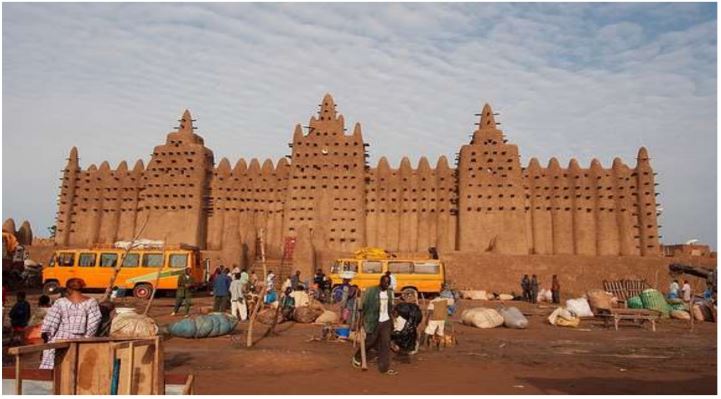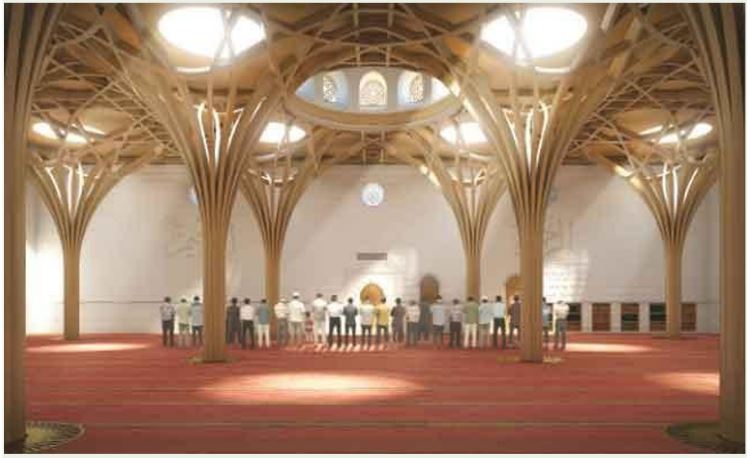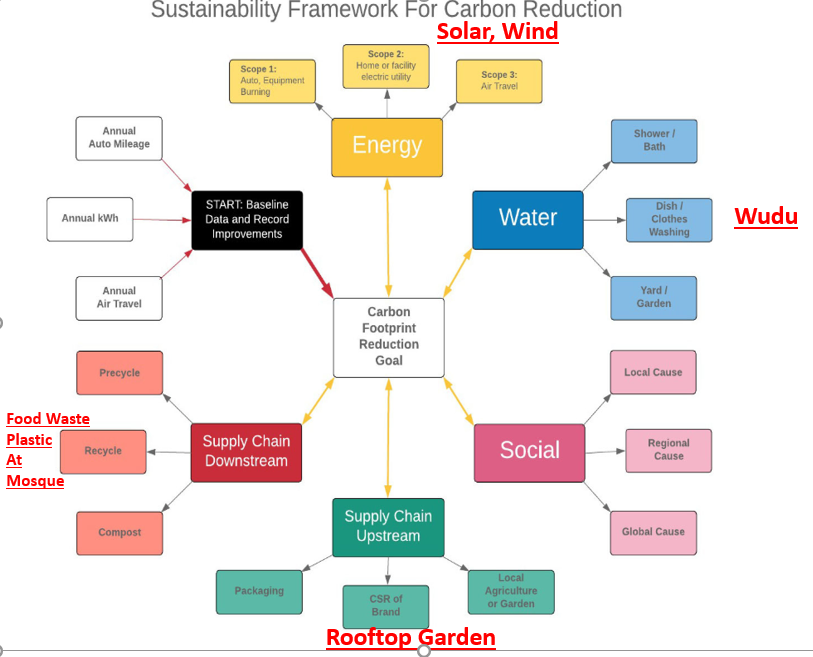Today's Mosques are breath-taking beautiful architectures (1), but also environmentally eroding!
Where are the environmental stewardship responsibilities in the construction and operation of the House of worship?
Has the Mosque become a museum, where people only attend during special events: Jumma, Ramadan and Eid?
The Mosque has traditionally been the epicenter of Muslim community activities: births, counseling, marriages, deaths, fundraisers, talks, Jumma & Eid prayers, and so on, and, concurrently, a learning center for the spiritual, Qoran, hadith, etc., and the secular that is back-linked to the former.
There are many facets of learning, and an important thread that ties humanity, bio-diversity, and planet is the environment. It's time we understand the link between man and his stewardship responsibilities towards the planet and future generations.
The media coverage on the environment has been led governments (signatory to Paris Climate Agreement), corporates (focusing on sustainability, as in UN Sustainability Development Goals), startups (eco-friendly products), NGOs (disintermediation of middlemen), and so on. But, much silence from the religious sector, at least, very little coverage.
In religion, the starting point is often the place of worship, be it a mosque, temple, synagogue, church, etc., as it is typically the initial place people search for finding 'their' community. Today, the religious communities have a common place to go on Friday (Muslims at Mosques), Saturday (Jews at Synagogues), Sunday (Christians at Churches), etc. But, how many eco-friendly Houses of Worship exist in the US, Europe and even the OIC (56 Muslim majority countries)?
Type in 'how many eco-friendly Hindu temples, Churches, Synagogues or Mosques in the US' in Google search engine, and the results are articles with general mission statements on stewardship responsibilities. Why? Because all faiths and ways of life speak in scripture of stewardship responsibilities to the planet and future generations.
The objectives of having eco-friendly Hindu Temple (2), Church (3), Synagogues, (4) Jewish (lab for sustainability), and Mosques (5) -emphasis on Green Ramadan- includes learning, linkages to UN SDGs, another stream for inter-faith dialogue, etc.
But, where are eco-friendly houses of worship?


Fast forward to the African country of Mali and Great Mosque of Djenne, below, at 700 years old, it continues the sustainability legacy as it was built out of mud bricks...'the foundation naturally regulates temperature, is repaired by the local community in an annual festival and happens to be the largest mud brick building in the world...' (6).

Jordan, a beautiful country with few natural resources (oil) but plenty of sunshine, is showing eco-leadership as nearly 100% of the mosques are using renewable energy, with '..Amman (as) one of more than 70 cities worldwide that are aiming to become "carbon neutral" by 2050, meaning they will produce no more climate-changing emissions than they can offset, such as by planting carbon-absorbing trees.' (7)
Indonesia has 'more than 800,000 mosques...but officials hope to create more eco-mosques after the initial 1,000 are established [by 2020]...the initiative will help the mosques to source renewable energy, manage their water and food needs sustainably, reduce and recycle waste and provide environmental education.. An eco-mosque roll-out of this scale is rare. In Dubai, a mosque built in 2014 was the first to meet the U.S. Green Building Council's guidelines, while Britain, the United States, Morocco and Malaysia all have mosques aiming to be more green...' (8)
In Cambridge, UK, the first eco-friendly mosque in Europe is set to open in 2019. '...Islamic civilization has been based on the rejection of waste as an under-estimation of God's blessing and so in the construction of the new mosque here in Cambridge, we were very much in the forefront of the local environmental movement...so that we'll have an almost zero carbon footprint," commented Chairman of the Trust, Tim Winter who is also known as Abdul Hakim Murad..' (9)

Finally, 'The International Islamic Climate Change Symposium, a gathering of 60 Islamic leaders from around the world, released a declaration (2015)...discussions on a climate change strategy...called on "well-off nations and oil-producing states" to institute policies that would keep the global temperature from increasing more than 2 degrees Celsius, the benchmark at which scientists predict the worst of global warming would set in... (10)
Where is the (center of) Muslim eco-leadership for Carbon Reduction?

The UN Sustainability Development Goals (SDGs), (12), signed by 193 countries, including most of the 56 Muslim majority countries (OIC), is basically a global compact to save ourselves from ourselves. The most important aspect of the SDGs is creating awareness and understanding of the 17 Goals, 169 targets and 304 indicators...We, Muslims, are linked to the color green, and green is associated with the environment, but there is not much green understanding by Muslims.
'A white elephant is a possession which its owner cannot dispose of and whose cost, particularly that of maintenance, is out of proportion to its usefulness. In modern usage, it is an object, building project, scheme, business venture, facility, etc., considered expensive but without use or value...' (13)
When Mosques are only busy during Jumma prayers, Ramadan and Eid, it can be said that it 'is out of proportion to its usefulness.' The challenge is what more can be done to increase and sustain attendance during the year; utilization for continuing education/events; attract young people's interest; and so on.
Mosques need to not only lower the electricity and water bills but more importantly, need to have a ROI (Return on Inspiration over Investment), ROE (Return on Environment over Equity) and ROC (Return on Community over Capital).
Thus, an eco-friendly Mosque presents a multi-prong approach to better understanding of our stewardship responsibilities towards the environment by (1) building a foundational infrastructure with corresponding attributes (discussed below), and, where (2) education, for children and adults, is by way of in-house worship' case study.
Furthermore, being the first eco-friendly mosque in the country facilitates dialogues with other Muslim and faith-based communities, aligns communities towards understanding UN SDGs responsibilities, expands the discussion on inter-faith dialogue, establishes a framework for career opportunities, so on.
The inspiration of the architecture must exemplary for the community: it must start with the glorious past, and must have attributes of submission of humility, access of functionality, pleasing of aesthetics, stimulation of the visual, and so on. Furthermore, it must be aligned to allow the seamless interaction of nature's elements of sun, water, air, and living creatures animals/birds/bees.
[Obviously, the upgrading of existing Mosques to become (more) eco-friendly is both difficult (remodeling construction) and somewhat easier (than building new)].
Build stage isn't just about obtaining an environmental impact statement for the proposed structure for government approval, but includes other issues, here are some of the more important areas: A. Water (Mosques are extremely water intensive, hence, holistic approach in collecting, using/reusing, etc., during ablution...low flow toilets, (rain) water collection facilities and waterless urinals).
Everyone has seen the sheer waste of water during Ablution (Wudu), and its time to think about an 'Eco-Wudu,' which serves the same purpose, but with less water.
For Wudu, would you use Zamzam water (brought from Mecca) the same was as you do for water from the tap at the Mosque, at the hotel, and at home? More below on water, waste and wudu.
B. Wood used in the infrastructure must be certified from sustainable forests (16); C. Renewable energy via solar panels, including insulation, plus battery storage, and, here, is a sampling of eco-leadership provided in Morocco (17);
D. Vertical or rooftop farm on Mosque. Important lessons from a hospital in Chicago on rooftop farming. (18). The eco-friendly Mosque should set an example for the community on growing its own vegetables, using recycled water and solar power, that can be 'own mini supermarket' for the built-in soup kitchen. A Google search has not found any such Mosques and closest is (19);
E. The usual activities in a mosque, weddings, Koran finishing dinners, fundraisers, Ramadan, etc., result in food leftovers/waste, (20), that which cannot be donated to local areas should be funneled to an on-site area for composting the food, which is then used (as food based fertilizer) for the rooftop farm. (21).
Operations
The operations of a Mosque have many moving parts, and, again for brevity and observations, will be confined to two prioritized areas. The objective is to make the Mosque once again the epicenter of socio-economic activity, especially on connecting with the youth, generating operational revenue, etc.
Putting water in "Quranic' context, where God mentions how He creates life (for plants, animals and man) and sustenance through water, "...Have you seen the water which you drink? Was it you who sent it down from the rain cloud, or did We send it? Were it Our will, We could have made it bitter; why then do you not give thanks?" (Quran, 56:68-70)
"And Allah has sent down rain from the sky and given life thereby to the earth after its lifelessness. Indeed in that is a sign for a people who listen." (Quran, 16:65)... "And We have sent down blessed rain from the sky and made grow thereby gardens and grain from the harvest." (Quran, 50:9)... "[We produce] gardens of grapevines and olives and pomegranates, similar yet varied. Look at [each of] its fruit when it yields and [at] it's ripening. Indeed in that are signs for a people who believe." (Quran, 6:99)... "We made from water every living thing..." (Quran, 21:30).
The use of water in context of Wudu, "And He caused rain to descend on you from heaven to cleanse you therewith..." (Quran, 8:11).
A Hadith (accuracy to be defined) on water and wudu: The Prophet (PBUH) passed by his companion Sa'd, who was washing for prayer, and said: "What is this wastage, O Sa' d?, " Is there wastage even in washing for prayer?" asked Sa'd, and he said, "Yes, even if you are by a flowing river!" Ibn Majah, Abu Dawud.
Two potential offerings from an eco-friendly Mosque: (1) Co-working space and (2) Mosque Tech Challenge. Today, Silicon Valley is synonymous with startups, these are the 'movers and shakers,' be it Facebook, Google, etc.
But, for many startup founders, one of the biggest challenges is how best to utilize their limited financial resources to find affordable 'office space' to build their billion dollar idea (Unicorn). Some startup founders understood the issue ('pain point') and the shared workspace concept has become a multibillion-dollar industry and growing. The poster child startup for shared workspace is Wework, (22), and it raised the concept globally with co-working office spaces, including many Muslim countries.
Mosques have ample (unused) space, hence, an opportunity to allocate room(s) with desk space to attract young Muslim (and non-Muslim) entrepreneurs to create and innovate. In general, by charging nominal amounts for desk space (per month) with internet connectivity and pantry full of halal food and mosque grown vegetables, it will attract young people with ideas/prototype, generate income for the mosque, and create the 'word-of-mouth' attraction of the mosque.
The above is not a novel concept, the young Muslims in Singapore understand the importance of connecting 'youth and mosques,' hence, created the Mosque Tech Challenge, (23). This is one is one of the more innovative, sustainable, and scalable ways to challenge the young Muslims to create solutions for the 'pain points' they and their community face. Obviously, in both cases, planning the 'platform' and mentoring is required.
Challenge for the youth: Blockchain use case and off-grid renewable energy production that can actually produce revenue for the Mosque. Here is some guidance (24).
Finally, as the local community multiplies, by births, reversions and relocation/moving, the mosque will need to structurally expand, and it must be done within the letter and spirit of sustainability and stewardship.
Thus, the time is now to build, convert, and/or upgrade within the spirit of Quba Mosque. A solid foundation built on not just environmental impact statement, but, more importantly, on operating environmental considerations filled with learnings, activities, discipline, self-sufficiencies, and connected to youth by way of technology and resulting socio-economic activities.
An eco-friendly Mosque will green Muslims.
2. https://www.treehugger.com/culture/hindu-leader-urges-temples-to-go-green.html
4. https://www.tabletmag.com/jewish-life-and-religion/257241/making-synagogues-sustainable and https://hazon.org/
5. http://www.isna.net/greenramadan/
6. https://www.islamicity.org/7942/the-form-of-the-prophets-mosque/
11. https://www.linkedin.com/pulse/sustainability-framework-carbon-reduction-george-h-thomas/
12. https://www.un.org/sustainabledevelopment/sustainable-development-goals/
13. https://en.wikipedia.org/wiki/White_elephant
14. https://www.iso.org/standard/63026.html
15. http://www.usgbc.org and https://www.epa.gov/smartgrowth/green-building-standards
16 https://www.weyerhaeuser.com/timberlands/forestry/sustainable-forestry/
17 https://www.dw.com/en/solar-panels-make-moroccos-mosques-a-model-for-green-energy/a-37583670
18. https://www.weisshospital.com/connect-with-us/rooftop-farm
19. http://www.mosqueplanting.org/
23. https://www.facebook.com/mosquetechchallenge/
24. http://fortune.com/2017/03/14/brooklyn-microgrid-solar-energy-blockchain-startup/